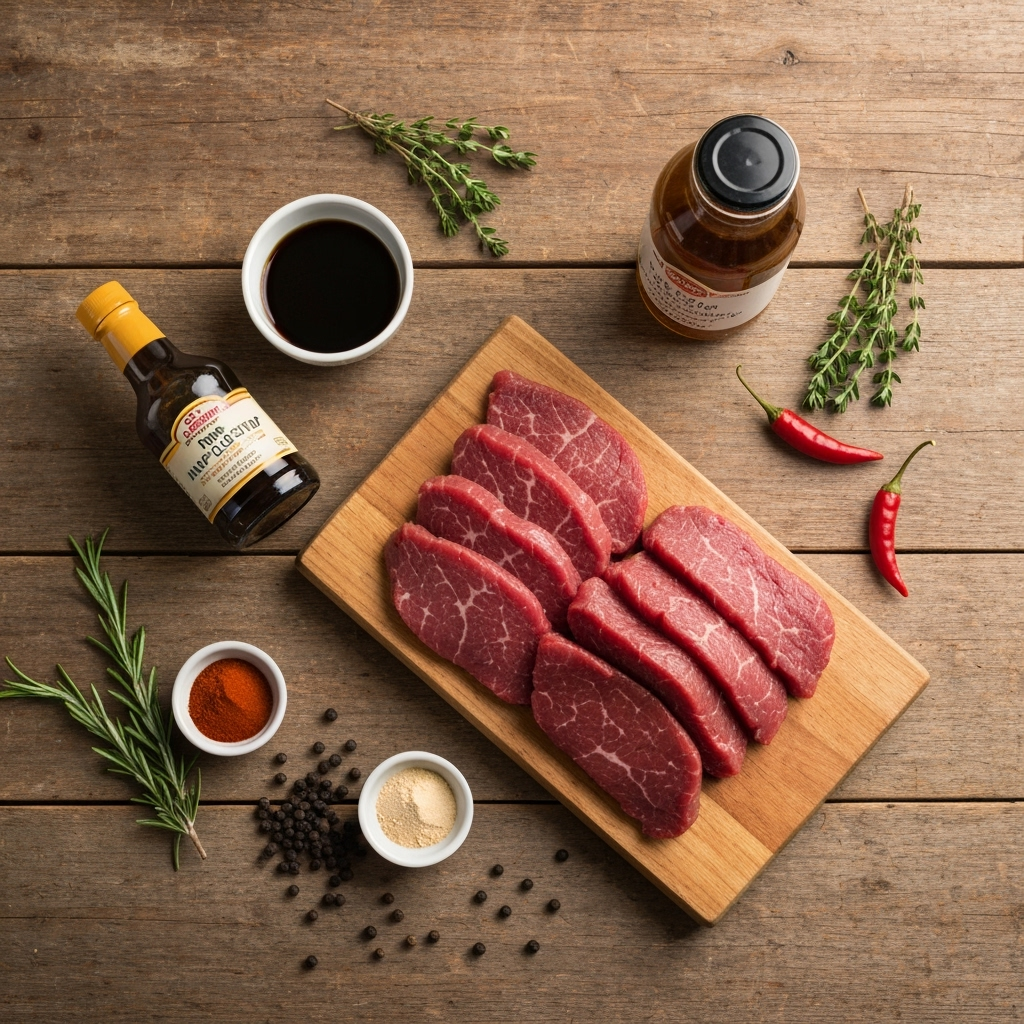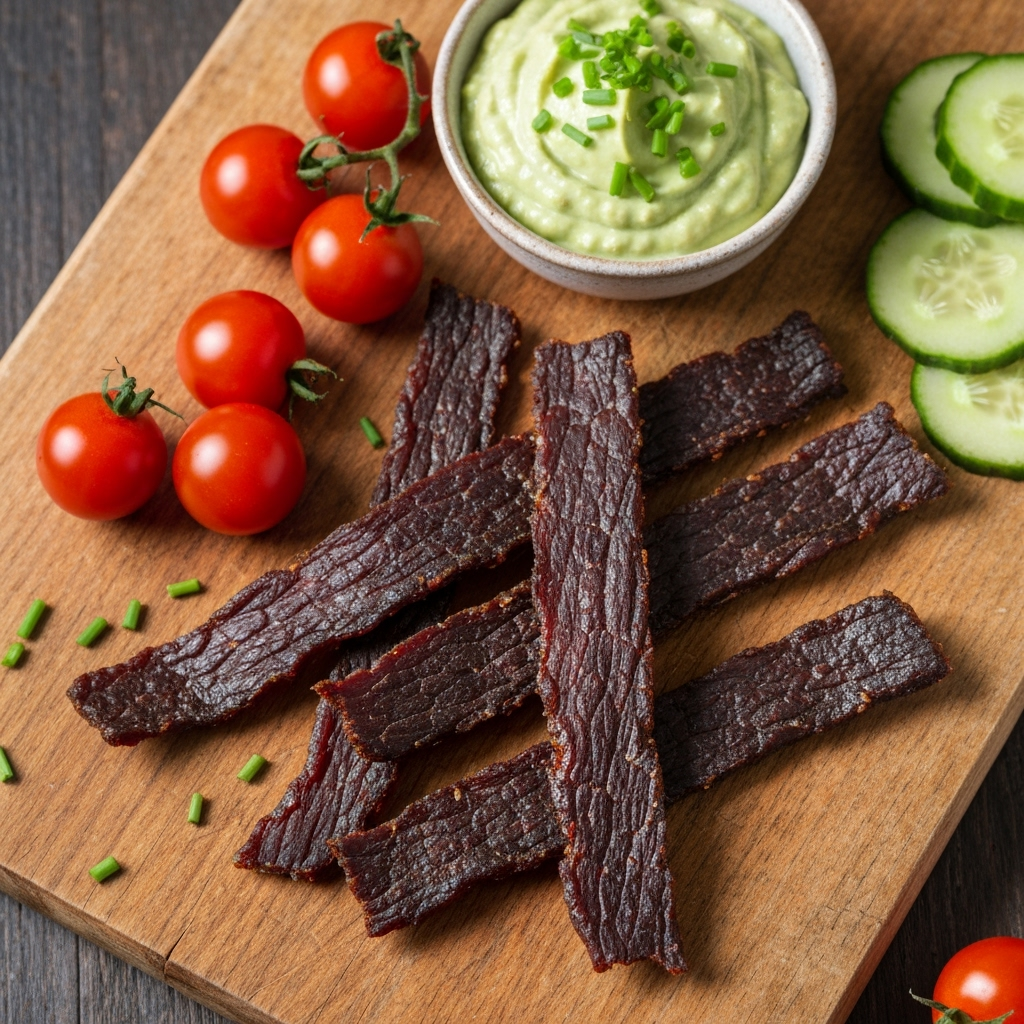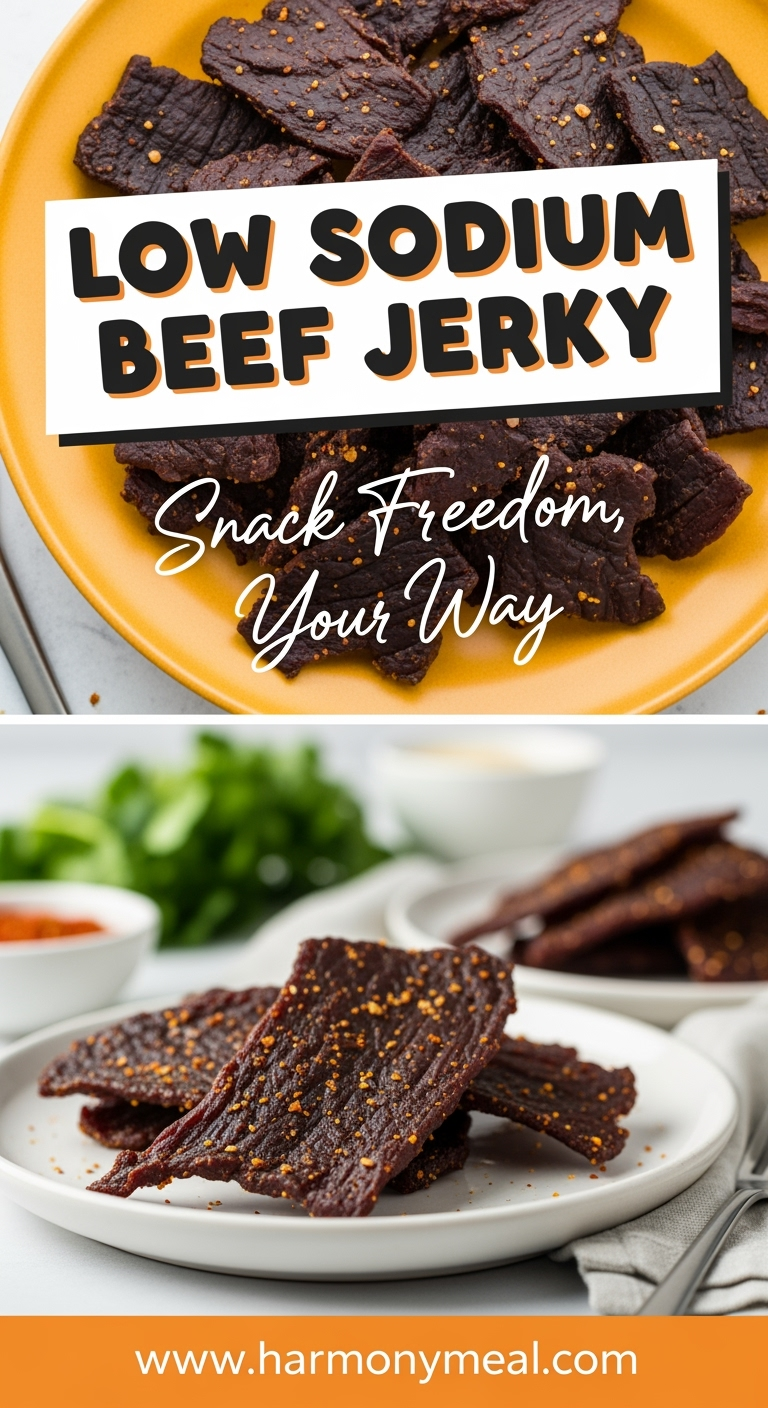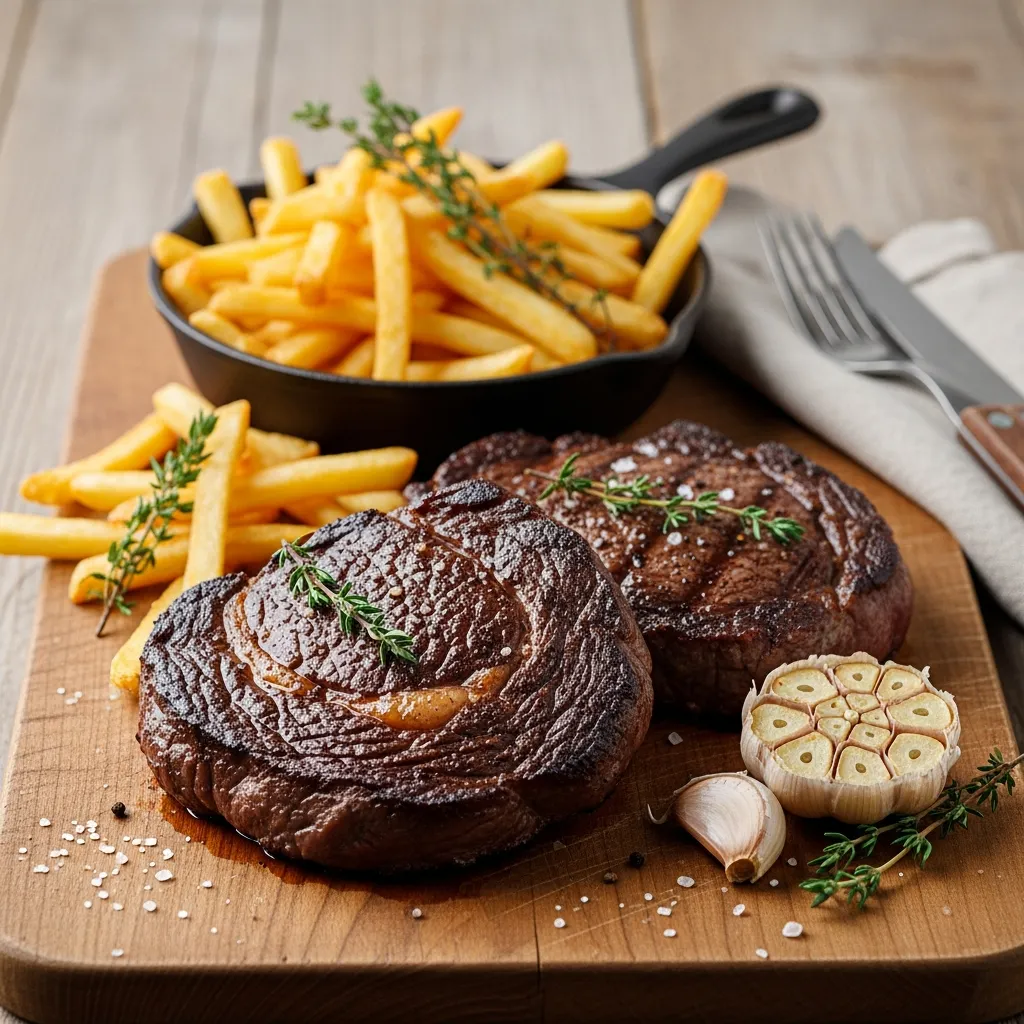There’s something deeply satisfying about pulling a batch of homemade low sodium beef jerky from the dehydrator. The rich, savory aroma fills the kitchen, promising a snack that’s not only delicious but also nourishing. I started making my own jerky years ago when my doctor suggested cutting back on sodium, and store-bought options left me disappointed—either too salty or packed with preservatives. Creating my own version meant I could control every ingredient, focusing on bold flavor without the health compromises. This low sodium beef jerky recipe has become my go-to for hiking trips, road snacks, and those mid-afternoon slumps when you need something substantial to keep you going. It’s easier than you might think, and the result is far superior to anything you’ll find in a package.
Table of Contents
Low Sodium Beef Jerky Ingredients

Creating delicious low sodium beef jerky starts with selecting the right components. The beauty of homemade jerky is that you can adjust flavors to your preference while keeping things healthy.
- 2 pounds lean beef (top round, sirloin, or flank steak)
- ½ cup low-sodium soy sauce or coconut aminos
- 2 tablespoons Worcestershire sauce (look for reduced-sodium version)
- 2 tablespoons apple cider vinegar
- 1 tablespoon pure maple syrup or honey
- 2 teaspoons smoked paprika
- 1 teaspoon garlic powder
- 1 teaspoon onion powder
- ½ teaspoon black pepper
- ¼ teaspoon cayenne pepper (optional, for heat)
- 1 teaspoon liquid smoke (optional, for extra smokiness)
Smart Substitutions: If you’re avoiding soy entirely, coconut aminos work beautifully. For a sugar-free option, omit the maple syrup or use a sugar-free substitute. You can experiment with different spice blends from our jerky seasoning guide to create your signature flavor.
Low Sodium Beef Jerky Timing
- Prep time: 20 minutes (plus 4-12 hours marinating)
- Cook time: 4-6 hours
- Total time: 4 hours 20 minutes to 18 hours
While the total time might seem long, most of it is hands-off marinating and dehydrating. The active prep time is surprisingly short—perfect for making on a weekend when you’re doing other things around the house.
Low Sodium Beef Jerky Step-by-Step Instructions
Making homemade jerky might seem intimidating, but it’s actually quite straightforward. Follow these steps for perfect results every time.
Step 1: Prepare the Beef
Start with partially frozen beef—it’s much easier to slice evenly. Trim away any visible fat, as fat doesn’t dehydrate well and can cause spoilage. Slice against the grain into ¼-inch thick strips. For tender jerky, check out our guide to the best meat for beef jerky to understand which cuts work best.
Step 2: Create the Marinade
In a medium bowl, whisk together low-sodium soy sauce, Worcestershire sauce, apple cider vinegar, maple syrup, and all spices. The acid in the vinegar helps tenderize the meat while the spices create depth of flavor. Taste the marinade and adjust seasonings if needed.
Step 3: Marinate the Beef
Place beef strips in a large resealable bag or shallow dish and pour the marinade over them. Ensure each piece is well-coated. Refrigerate for at least 4 hours, though overnight marinating yields the most flavorful results. The longer it marinates, the more pronounced the flavors will be.
Step 4: Dehydrate the Jerky
Remove beef from marinade and pat dry with paper towels—this helps with even drying. Arrange strips in a single layer on dehydrator trays or baking sheets if using an oven. Leave space between pieces for air circulation. Dehydrate at 160°F for 4-6 hours or until jerky is dry but still pliable.
Step 5: Test for Doneness
The jerky should bend without breaking and shouldn’t feel moist or soft. If it cracks when bent, it’s over-dried. Remember that jerky will continue to firm up as it cools, so remove it when it’s slightly more flexible than your desired final texture.
Low Sodium Beef Jerky Nutritional Information
This homemade low sodium beef jerky isn’t just delicious—it’s packed with nutritional benefits that make it a smart snacking choice.
- Calories: 85 per ounce
- Protein: 12g
- Carbohydrates: 2g
- Fat: 3g
- Sodium: 120mg
Compared to commercial jerky that can contain 400-600mg of sodium per serving, this homemade version provides all the protein power with significantly less sodium. It’s also free from preservatives and artificial ingredients commonly found in store-bought options.
Low Sodium Beef Jerky Equipment Needed
You don’t need fancy equipment to make great jerky, though having the right tools makes the process smoother.
- Sharp chef’s knife or electric knife for even slicing
- Cutting board
- Measuring spoons and cups
- Large resealable bags or glass container for marinating
- Dehydrator or oven with baking sheets
- Wire racks (if using oven method)
- Paper towels for patting dry
If you’re using an oven instead of a dehydrator, simply place the beef strips on wire racks set over baking sheets to allow air circulation. The oven method works perfectly well, though it may require slightly more attention to prevent over-drying.
Why You’ll Love This Low Sodium Beef Jerky Recipe
This recipe has become a staple in my kitchen for several compelling reasons that might resonate with your lifestyle too.
Total Control Over Ingredients: You know exactly what’s going into your snack—no hidden preservatives, MSG, or excessive sodium that often plagues commercial jerky.
Cost Effective: Homemade jerky costs significantly less than premium store-bought versions, especially when you buy beef in larger quantities.
Customizable Flavors: Once you master the basic recipe, you can experiment with different spice blends and marinades to create your perfect jerky profile.
Perfect for Active Lifestyles: This high-protein snack is ideal for hiking, travel, or busy days when you need sustained energy without processed ingredients.
Satisfying Project: There’s something deeply rewarding about transforming simple ingredients into a shelf-stable, delicious snack through your own efforts.
Healthier Alternatives for Low Sodium Beef Jerky
While this recipe is already quite healthy, there are several ways to adjust it for specific dietary needs or preferences.
For a completely soy-free version, use coconut aminos instead of low-sodium soy sauce. They provide a similar umami flavor with even less sodium. If you’re monitoring sugar intake, simply omit the maple syrup or use a sugar-free alternative like monk fruit sweetener. You can also experiment with different protein sources—the techniques learned here apply equally well to making venison jerky or turkey jerky.

For those interested in other healthy jerky options, our article on the healthiest beef jerky explores additional nutritional considerations and preparation methods.
Low Sodium Beef Jerky Serving Suggestions
This versatile snack goes beyond just eating straight from the bag. Here are some creative ways to enjoy your homemade jerky.
Trail Mix Upgrade: Chop jerky into small pieces and mix with nuts, seeds, and dried fruit for a high-energy trail mix that’s perfect for hiking or long drives.
Salad Topper: Thinly slice or crumble jerky over green salads for a protein boost that adds savory depth without needing salty dressings.
Charcuterie Boards: Include jerky strips on your next cheese board alongside olives, nuts, and fresh fruit for a balanced snack spread.
Soup Garnish: Add chopped jerky to vegetable soups or stews during the last few minutes of cooking for extra flavor and texture.
Lunchbox Surprise: Pack a few strips in lunchboxes alongside sandwiches or wraps for a satisfying protein addition that keeps you full longer.
Common Mistakes to Avoid with Low Sodium Beef Jerky
Even experienced cooks can encounter issues when making jerky for the first time. Here’s how to avoid common pitfalls.
Skipping the Fat Trimming: Leaving fat on the beef can lead to spoilage and off-flavors. Fat doesn’t dehydrate well and can become rancid during storage.
Uneven Slicing: Inconsistent thickness means some pieces will dry out while others remain underdone. Using partially frozen meat makes uniform slicing much easier.
Over-marinating: While flavor develops over time, marinating for more than 24 hours can sometimes make the texture mushy. Four to twelve hours is typically ideal.
Rushing the Drying Process: Increasing temperature to speed up drying can result in jerky that’s tough on the outside and under-dried inside. Patience yields better texture.
Skipping the Pat-Dry Step: Not removing excess marinade before dehydrating can make the jerky sticky and extend drying time significantly.
Storing Low Sodium Beef Jerky
Proper storage is crucial for maintaining quality and safety of your homemade jerky.
After dehydration, allow jerky to cool completely before storing. Place in airtight containers or vacuum-sealed bags. Glass jars with tight-fitting lids work particularly well. Store in a cool, dark place for up to 2 months. For longer storage, keep in the refrigerator where it will maintain quality for 3-4 months, or freeze for up to 6 months.
If you notice any moisture condensation in the storage container, the jerky needs additional drying time. Properly dried jerky should have no visible moisture and should feel firm but pliable. For best flavor and texture, consume within the first month of making.

Low Sodium Beef Jerky Conclusion
Making your own low sodium beef jerky is one of those kitchen projects that feels incredibly rewarding. You start with simple ingredients and through patience and care, transform them into a healthy, portable snack that puts commercial options to shame. The ability to control sodium levels while maximizing flavor means you can enjoy this protein-packed treat without compromising your health goals. Whether you’re packing it for adventures, stashing some in your desk drawer for afternoon cravings, or sharing with friends who appreciate real food, this jerky delivers on both taste and nutrition.
I’d love to hear how your low sodium beef jerky turns out! Share your experiences or favorite flavor variations in the comments below. Don’t forget to tag @Harmonymeal on Pinterest when you post photos of your homemade jerky creations. If you enjoyed mastering this recipe, you might also appreciate exploring our jerky marinade variations for your next batch.
FAQs about low sodium beef jerky
Is there low sodium beef jerky available?
Yes, many brands now offer specific u0022low sodiumu0022 or u0022reduced sodiumu0022 beef jerky options. These are formulated to contain significantly less sodium than traditional jerky, catering to health-conscious consumers.
What is considered low sodium for beef jerky?
For packaged foods, u0022low sodiumu0022 typically means 140 mg or less per serving. u0022Reduced sodiumu0022 means at least 25% less sodium than the original product. When buying beef jerky, look for these labels and check the nutrition facts for sodium content per serving.
Which beef jerky brands are known for low sodium options?
Several brands cater to low sodium preferences, including some lines from Jack Link’s, Old Trapper, and Tillamook. Additionally, smaller craft jerky makers often prioritize healthier formulations. Always check the nutrition label for specific sodium content.
How much sodium is typically found in regular beef jerky?
A typical 1-ounce serving of regular beef jerky can contain anywhere from 400 mg to over 600 mg of sodium. This high level is primarily due to salt being a crucial ingredient in the curing and flavoring process.
Can I make my own low sodium beef jerky at home?
Absolutely. Making homemade beef jerky allows you to control the sodium content completely. You can use less salt or replace a portion of it with salt-free seasonings, herbs, and spices like garlic powder, onion powder, paprika, or black pepper for flavor.
Is beef jerky a good snack for a low-sodium diet?
Only specific low-sodium beef jerky products are suitable for a low-sodium diet. Traditional beef jerky is very high in sodium and should be avoided. Always choose products explicitly labeled u0022low sodiumu0022 or u0022reduced sodiumu0022 and monitor your intake.
low sodium beef jerky
There’s something deeply satisfying about pulling a batch of homemade low sodium beef jerky from the dehydrator. The rich, savory aroma fills the kitchen, promising a snack that’s not only delicious but also nourishing. I started making my own jerky years ago when my doctor suggested cutting back on sodium, and store-bought options left me disappointed—either too salty or packed with preservatives. Creating my own version meant I could control every ingredient, focusing on bold flavor without the health compromises. This low sodium beef jerky recipe has become my go-to for hiking trips, road snacks, and those mid-afternoon slumps when you need something substantial to keep you going. It’s easier than you might think, and the result is far superior to anything you’ll find in a package.
- Prep Time: 20 minutes
- Cook Time: 4-6 hours
- Total Time: 4 hours 20 minutes to 18 hours
- Yield: About 12 ounces 1x
- Category: Snacks
- Method: Dehydrating
- Cuisine: American
Ingredients
- 2 pounds lean beef (top round, sirloin, or flank steak)
- ½ cup low-sodium soy sauce or coconut aminos
- 2 tablespoons Worcestershire sauce (look for reduced-sodium version)
- 2 tablespoons apple cider vinegar
- 1 tablespoon pure maple syrup or honey
- 2 teaspoons smoked paprika
- 1 teaspoon garlic powder
- 1 teaspoon onion powder
- ½ teaspoon black pepper
- ¼ teaspoon cayenne pepper (optional, for heat)
- 1 teaspoon liquid smoke (optional, for extra smokiness)
Instructions
- Prepare the Beef: Start with partially frozen beef—it’s much easier to slice evenly. Trim away any visible fat, as fat doesn’t dehydrate well and can cause spoilage. Slice against the grain into ¼-inch thick strips.
- Create the Marinade: In a medium bowl, whisk together low-sodium soy sauce, Worcestershire sauce, apple cider vinegar, maple syrup, and all spices. The acid in the vinegar helps tenderize the meat while the spices create depth of flavor. Taste the marinade and adjust seasonings if needed.
- Marinate the Beef: Place beef strips in a large resealable bag or shallow dish and pour the marinade over them. Ensure each piece is well-coated. Refrigerate for at least 4 hours, though overnight marinating yields the most flavorful results.
- Dehydrate the Jerky: Remove beef from marinade and pat dry with paper towels—this helps with even drying. Arrange strips in a single layer on dehydrator trays or baking sheets if using an oven. Leave space between pieces for air circulation. Dehydrate at 160°F for 4-6 hours or until jerky is dry but still pliable.
- Test for Doneness: The jerky should bend without breaking and shouldn’t feel moist or soft. If it cracks when bent, it’s over-dried. Remember that jerky will continue to firm up as it cools, so remove it when it’s slightly more flexible than your desired final texture.
Notes
Proper storage is crucial for maintaining quality and safety of your homemade jerky. After dehydration, allow jerky to cool completely before storing. Place in airtight containers or vacuum-sealed bags. Glass jars with tight-fitting lids work particularly well. Store in a cool, dark place for up to 2 months. For longer storage, keep in the refrigerator where it will maintain quality for 3-4 months, or freeze for up to 6 months. If you notice any moisture condensation in the storage container, the jerky needs additional drying time.
Nutrition
- Serving Size: 1 ounce
- Calories: 85
- Sugar: 1g
- Sodium: 120mg
- Fat: 3g
- Saturated Fat: 1g
- Unsaturated Fat: 2g
- Trans Fat: 0g
- Carbohydrates: 2g
- Fiber: 0g
- Protein: 12g
- Cholesterol: 25mg
💬 Let’s Stay Connected!
For daily recipes, kitchen tips, and exclusive content, follow me on:
👉 Facebook for behind-the-scenes & community fun
👉 Pinterest for visual inspiration & meal ideas
👉 X (Twitter) for quick tips & trending recipes
📲 Join the flavor journey, your next favorite recipe is just a follow away!












